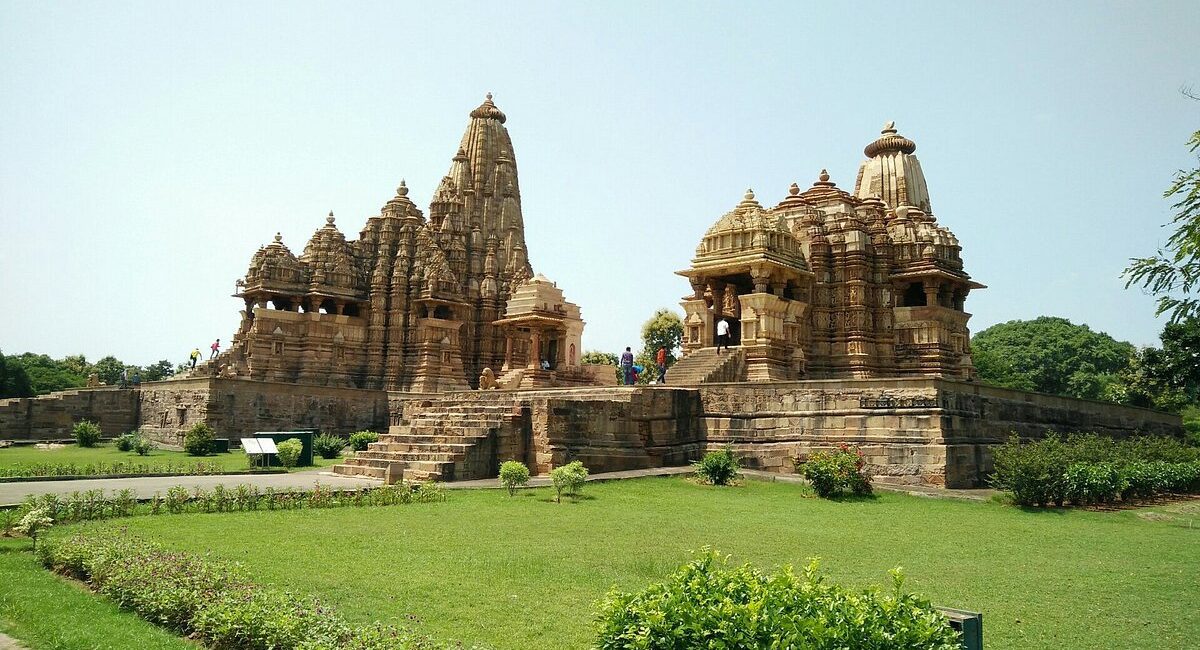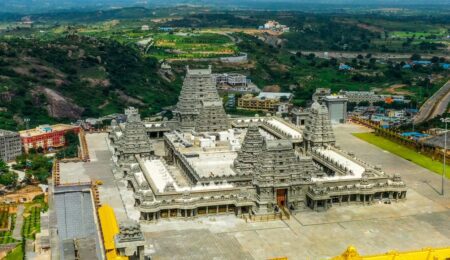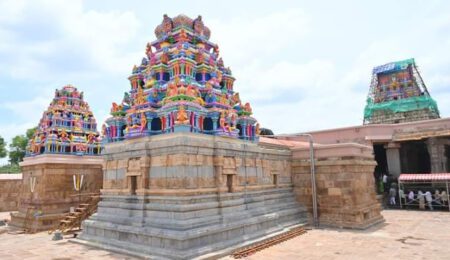Devi Jagadambi Temple Khajuraho: A Divine Jewel of Chandela Artistry
Introduction
In the heart of India’s spiritual landscape lies a temple that radiates both divine grace and artistic mastery the Devi Jagadambi Temple Khajuraho. Part of the world-renowned Khajuraho Group of Monuments, this temple is a sublime expression of devotion, sculpture, and architectural finesse. Though often overshadowed by the towering Kandariya Mahadev Temple, Devi Jagadambi Temple holds its own as a beacon of feminine divinity and refined craftsmanship.
This article offers a complete guide to the temple’s history, architecture, religious significance, and travel logistics—complete with Devi Jagadambi Temple photos, best visiting times, and how to reach this sacred site. Whether you’re a cultural enthusiast, a spiritual seeker, or a digital storyteller, this temple deserves a place in your narrative.
Historical Background of Devi Jagadambi Temple
The Chandela Legacy
The Chandela dynasty, which ruled central India from the 9th to the 13th century, was instrumental in creating the Khajuraho temples. These rulers were not just patrons of war and politics—they were visionaries who saw art and spirituality as intertwined forces. Under their reign, Khajuraho flourished as a center of Tantric Shaivism, Vaishnavism, and Shakta worship.
The Devi Jagadambi Temple was constructed during the early 11th century, likely under the reign of King Ganda or King Vidyadhara, both known for their contributions to temple architecture.
Transition of Deity
Originally believed to be dedicated to Lord Vishnu, the temple later became associated with Devi Jagadambi, a fierce yet nurturing form of the Mother Goddess. This transition reflects the fluidity of Hindu worship, where the same sanctum can evolve to honor different aspects of divinity over time.
UNESCO Recognition
In 1986, the Khajuraho Group of Monuments, including Devi Jagadambi Temple, was declared a UNESCO World Heritage Site for its outstanding universal value in art, architecture, and spirituality.
Architectural Details: Nagara Style Elegance
Structural Overview
The temple is a classic example of Nagara-style architecture, which dominates northern India. Unlike the Dravidian temples of the south, Nagara temples feature curvilinear shikharas, elevated platforms, and intricate carvings that wrap around the entire structure.
| Architectural Element | Description |
|---|---|
| Shikhara (Spire) | Curved tower rising above the sanctum |
| Mandapa | Pillared hall for devotees |
| Jagati | Raised platform for prominence |
| Sanctum (Garbhagriha) | Houses the deity, Devi Jagadambi |
| Sculptural Bands | Three horizontal layers of carvings |
Unique Features
- Compact Layout: Unlike the sprawling Kandariya Mahadev Temple, Devi Jagadambi Temple is more intimate, allowing for closer interaction with its sculptures.
- Single Mandapa: The temple has one main hall, emphasizing simplicity and focus.
- No Circumambulatory Path: Built in the nirandhara style, which omits the pradakshina path, directing all attention to the central deity.
Stone and Craftsmanship
Crafted from sandstone, the temple’s carvings have withstood centuries of weathering. The artisans employed interlocking techniques without mortar, showcasing advanced engineering for the time.
Artistic Sculptures and Iconography
Divine Feminine in Stone
The temple’s central figure, Devi Jagadambi, is depicted in a black-painted idol, often mistaken for Kali due to her fierce expression. However, her posture and ornamentation suggest a more benevolent form of Parvati, symbolizing Shakti the cosmic energy that sustains the universe.
Erotic Imagery and Tantric Symbolism
Khajuraho’s temples are famous for their erotic sculptures, which are not mere depictions of sensuality but symbolic representations of cosmic union. These carvings reflect Tantric philosophy, where physical intimacy is a metaphor for spiritual transcendence.
| Sculpture Type | Symbolism |
|---|---|
| Mithuna Couples | Union of Purusha and Prakriti |
| Apsaras | Divine beauty and grace |
| Dikpalas | Guardians of cosmic directions |
| Trinity with Consorts | Harmony of divine masculine and feminine |
Noteworthy Carvings
- Three-headed Shiva: A rare depiction with eight arms, symbolizing omnipresence.
- Varaha Avatar: Vishnu lifting Bhudevi, carved with dynamic realism.
- Celestial Musicians: Apsaras playing instruments, frozen in rhythmic motion.
- Yama and Nirriti: Guardians of death and destruction, placed strategically on the southern walls.
These sculptures are arranged in horizontal bands, each telling a story—from daily life to divine myths.
Cultural and Religious Significance
Devi Jagadambi: Mother of the Universe
The name Jagadambi translates to “Mother of the World.” She is revered as a protector, nurturer, and destroyer of evil. Her presence in Khajuraho signifies the primacy of feminine energy in Hindu cosmology.
Spiritual Experience
Though the temple is no longer used for daily rituals, it remains a spiritual magnet. Devotees often sit in silent meditation, absorbing the energy of the sanctum. The ambiance, enhanced by the carvings and natural light, creates a sacred atmosphere conducive to introspection.
How to Reach Devi Jagadambi Temple Khajuraho
By Air
- Nearest Airport: Khajuraho Airport (HJR)
- Distance: Approximately 5 km from the temple
- Connectivity: Regular flights from Delhi, Varanasi, and Mumbai
By Rail
- Nearest Station: Khajuraho Railway Station (KURJ)
- Distance: Approximately 6 km
- Major Trains: Mahakoshal Express, Bundelkhand Express, UP Sampark Kranti
By Road
- From Jhansi: Approximately 175 km via NH39
- From Satna: Approximately 120 km via NH35
- From Bhopal: Approximately 375 km via NH86
- Local Transport: Auto-rickshaws, taxis, and e-rickshaws available
Visiting Hours, Entry Fees and Travel Tips
| Detail | Information |
|---|---|
| Visiting Hours | 7:00 AM – 6:00 PM |
| Entry Fee (Indian Citizens) | ₹40 |
| Entry Fee (Foreign Nationals) | ₹600 |
| Photography | Allowed (except inside sanctum) |
| Guide Services | Available at entrance |
| Accessibility | Limited wheelchair access |
Travel Tips
- Best Time to Visit: October to March (cool and pleasant)
- Avoid Summer: April to June can be scorching
- Combine with Nearby Temples: Kandariya Mahadev, Chitragupta, Vishwanath
- Attend Khajuraho Dance Festival: Held in February, showcasing classical Indian dance against the temple backdrop
Nearby Attractions and Suggested Itinerary
A visit to Devi Jagadambi Temple Khajuraho is best experienced as part of a broader exploration of the Khajuraho temple complex, which includes both Western and Eastern groups of temples. Here’s how you can plan your itinerary:
Western Group of Temples (Walking Distance)
- Kandariya Mahadev Temple: The largest and most ornate temple in Khajuraho, dedicated to Lord Shiva.
- Chitragupta Temple: Dedicated to Surya, the Sun God, with stunning depictions of royal processions.
- Lakshmana Temple: One of the oldest temples, known for its elaborate friezes and sanctum.
- Vishwanath Temple: Features a majestic Nandi bull and exquisite carvings.
Eastern Group of Temples
- Parshvanatha Temple: A Jain temple with detailed carvings of celestial beings and flora.
- Adinatha Temple: Dedicated to the first Jain Tirthankara, with a simpler yet elegant design.
Southern Group of Temples
- Duladeo Temple: A late-period Shiva temple with softer, more stylized sculptures.
- Chaturbhuj Temple: Unique for its massive Vishnu idol and absence of erotic imagery.
Suggested Itinerary
Day 1: Arrive in Khajuraho, visit Western Group of Temples including Devi Jagadambi Temple Day 2: Explore Eastern and Southern groups, attend the evening sound and light show Day 3: Visit nearby attractions like Raneh Falls, Panna National Park, and the Archaeological Museum
Local Culture and Festivals
Khajuraho is not just about temples it’s a living cultural landscape. The town hosts several festivals and events that celebrate its heritage.
Khajuraho Dance Festival
Held every February, this week-long festival showcases classical Indian dance forms like Bharatanatyam, Kathak, Odissi, and Kuchipudi. The performances take place against the illuminated backdrop of the temples, creating a surreal experience.
Navratri Celebrations
During Navratri, Devi Jagadambi Temple becomes a focal point for local devotees. Though formal rituals are limited, the temple is adorned with flowers and lamps, and visitors offer prayers to the goddess.
Local Crafts and Cuisine
- Handicrafts: Look for sandstone miniatures, tribal jewelry, and handwoven textiles.
- Cuisine: Try local Bundelkhandi dishes like bhutte ka kees, kachori, and poha at nearby eateries.
Conservation and Preservation Efforts
The Archaeological Survey of India (ASI) oversees the maintenance and conservation of Devi Jagadambi Temple. Key initiatives include:
- Structural Reinforcement: Periodic restoration of weathered carvings and stone joints.
- Visitor Management: Controlled foot traffic and signage to protect fragile areas.
- Digital Documentation: 3D scanning and archival photography for long-term preservation.
Visitors are encouraged to respect the sanctity of the site by avoiding littering, touching sculptures, or climbing on temple structures.
Frequently Asked Questions (FAQs)
Q1: Is Devi Jagadambi Temple still active for worship? No, it is not an active temple for daily rituals but remains a revered site for meditation and spiritual visits.
Q2: Are guides available at the temple? Yes, certified guides are available at the entrance. Audio guides and multilingual brochures are also offered.
Q3: Can I take photos inside the temple? Photography is allowed in the outer areas but prohibited inside the sanctum.
Q4: Is the temple accessible for elderly visitors? There are steps leading to the temple platform, so assistance may be needed for elderly or differently-abled visitors.
Q5: What is the dress code for visiting the temple? Modest attire is recommended out of respect for the sacred environment.
Conclusion
The Devi Jagadambi Temple Khajuraho is a timeless ode to divine femininity, artistic excellence, and spiritual depth. Its carvings speak of cosmic truths, its sanctum radiates quiet power, and its architecture bridges the earthly and the eternal. Whether you’re documenting India’s sacred geography, curating SEO-rich content, or simply seeking a moment of transcendence, this temple offers a profound experience.
With its rich history, stunning visuals, and cultural resonance, Devi Jagadambi Temple is not just a destination it’s a revelation.




Leave a Comment